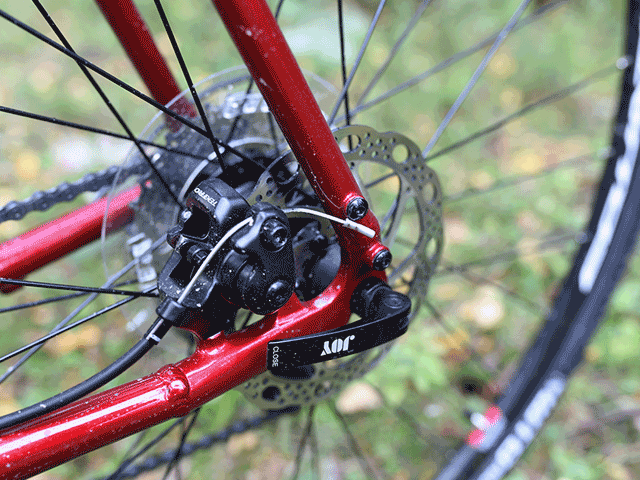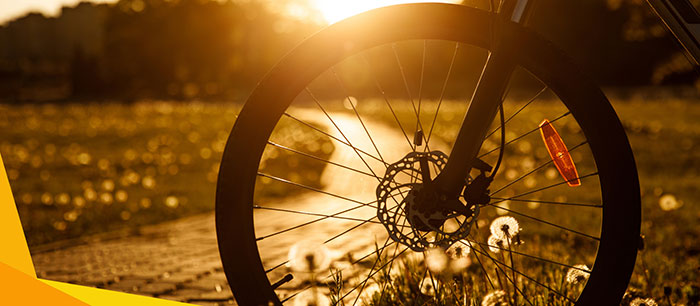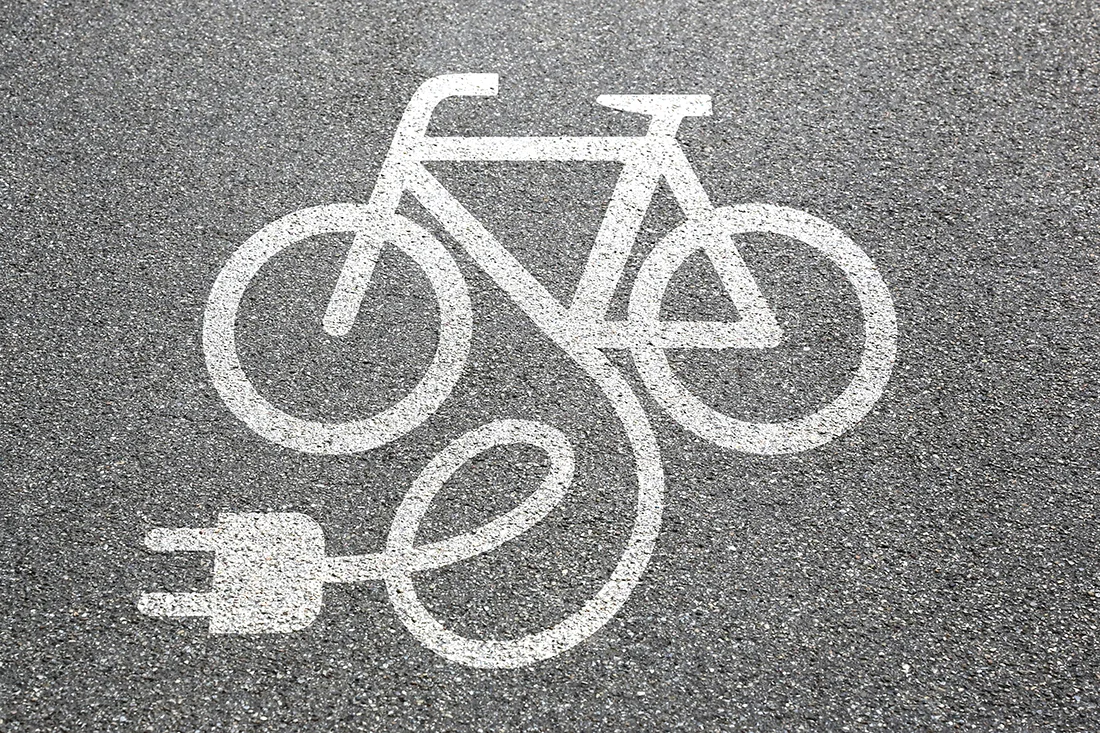Disc brakes have become very big in all disciplines of cycling over the past ten years. They first originated in mountain biking and then came across to touring, cyclocross, and even road racing.
Many people tried to get them banned, saying they were too dangerous for racing in groups, and now you see them on nearly every bike in the Peloton.
What are disc brakes though, and what different types will you find on the market?
In this article, we’re going to tell you everything you need to know about mechanical disc brakes, hydraulic disc brakes, and why you should consider having them on your bike.
Contents
How Do Disc Brakes Work?
Disc brakes work very differently from standard rim brakes, and they have a huge amount of advantages.
The disc brake system consists of a disc that attaches to the wheel, a caliper that attaches to the bike, and a lever on the handlebars.
The disc will spin with the wheel, and the caliper will sit stationary on the bike along with the lever. The disc spins through the caliper, and when the brake lever is pulled, pistons come out of the caliper and push brake pads into the disc, which slows the bike down. When the lever is released, the piston releases the grip, and you can speed up again.
Related: Different Brake Types Explained
You get amazing advantages with this braking system, such as:
- No wear on your wheels
- More powerful braking
- Work effectively in all conditions
- Dissipate heat much better
- Typically require less servicing
They do come with a few drawbacks that must be mentioned, such as:
- More expensive to buy
- It can be harder to set up
- Weigh slightly more
- Are more costly to maintain
There are two types of disc brakes you have mechanical, and you have hydraulic. They both work in the same principle but are very different internally, and you get advantages and disadvantages with each.
How Do Mechanical Disc Brakes Work?

Mechanical brakes are the oldest form of disc brakes and are the most basic. As above, they work with a system where you pull the levers, and the brake pads close onto the discs.
What makes mechanical different, is the fact when you pull the lever, it closes the pistons with the use of a steel cable.
These are the kind of cables you will find in a typical rim braking system. The cable goes from the lever to the caliper and will consist of an outer sheath and an inner steel cable.
Using a cable to operate the brakes means they are very easy to set up, very easy to adjust, and very cheap to maintain.
It doesn’t have as much power as other systems, and you will find they will need regular adjustments as the discs and pads wear down and the cable wears in and stretches over time. We are seeing fewer mechanical braking systems available to buy as the more popular one is currently hydraulic.
How Do Hydraulic Disc Brakes Work?
Hydraulic disc brakes are the most popular and the most modern form of disc brakes on the market currently. They work very differently from mechanical brakes and are very efficient.
What happens in a hydraulic braking system is from the lever to the caliper, instead of having a cable, you have fluid. When you pull the lever, it pushes the fluid down the system, and that pushes the brake pads onto the discs.
Having a hydraulic system is very powerful, and the brakes will feel very responsive. On top of that, many systems on the market have a fantastic ability to self-adjust the pads closer and closer to discs as they wear down.
You get no cable stretch, and they require much less servicing than a mechanical system. They are harder to work on and do require special tools as they require to be bled, and this can be challenging.
You do get some systems that actually use a cable and also a hydraulic system together, and these were quite big with companies like Giant. Unfortunately, they didn’t catch on, and now very few are seen on the market.
Hydraulic vs Mechanical Disc Brakes
Although they work on the same principle, there are some major differences, and the best way to explain them is to break them down into sections to tell you where you will get the best advantages and disadvantages from each disc brake.
Hydraulic disc brakes are much more powerful and have a much better response time. This is due to not having any lag or stretch from the cable. It is a very noticeable difference, and once you have gone hydraulic, it is challenging to go back to cable.
You typically have much less maintenance on hydraulic disc brakes than on mechanical disc brakes.
This is because they are self-adjusting and hydraulic fluid lasts much longer than a cable if properly looked after. Hydraulics are harder to maintain, and you do require a bleeding kit and other specialist tools to work on them.
Read more: Why Bike Is Maintenance
Mechanical disc brakes are much easier to work on. Changing a cable is very easy and can be done with as little as a multi-tool. They require more attention and will need adjusting regularly, but to look after, but the jobs are very simple and easy to do.
When comparing them, the last thing to mention is that hydraulic disc brakes are much easier to use than mechanical brakes. You literally just have to feather hydraulic disc brakes compared to having to pull on mechanical disc brakes.
Generally, hydraulic brakes are more expensive than mechanical brakes. With the extra performance and lower maintenance, the cost is typically higher. You will find prices do massively vary from basic brakes to high-end brakes on both mechanical and hydraulic.
What Kinds of Bikes Have Disc Brakes?
Typically when it comes to disc brakes, you will always see them on modern mountain bikes. They are very beneficial in mountain biking because they are so powerful and can work in all conditions, even when it is seriously muddy and wet.
You will also see disc brakes on touring bikes. They are fantastic when carrying large loads because of their braking power. Also, the mechanical versions being very easy to work on the roadside make them a perfect choice for long distance riding across countries.
In modern times we are actually seeing disc brakes on all types of bikes. Not just road bikes but cyclocross bikes, gravel bikes, road bikes, and even time trial bikes. They are the way forward in the industry, and as they become more popular and accepted, the less we see rim brakes.
Read more: Types of Bikes
Frequently Asked Questions
What is a disc brake?
A disc brake is where, instead of the brake pads closing in on the wheel rim, it closes in on a disc that is attached to the wheel. Disc brakes are a much more efficient system and work in all conditions very well.
Why are disc brakes better?
They are much more powerful, require very little maintenance, are much easier to use on the hands, work in all conditions, and don’t wear down your wheel's rim surface.
Are disc brakes really worth it?
They are completely worth it. They are just so much more responsive, they are much easier when it comes to bike handling, and just so much easier on the hands to use.
What are the types of disc brakes?
The two types are hydraulic and mechanical. There are some systems with both, but these are not very popular. The most common you will see on the market, especially on mountain bikes, are hydraulic brakes.
What are the disadvantages of disc brakes?
They are more expensive when it comes to buying and servicing them. They do require more attention compared to rim brakes. The performance and reliability completely outweigh the cost.
Can you upgrade a bike to disc brakes?
Typically no, you can’t. Frames are made for either disc or rim brakes, and converting across is very expensive and very difficult to do. They do make conversion kits, but I wouldn’t recommend using these as they aren't very good and don’t work as proper disc brakes should. Your best bet is to sell the rim brake bike you have and replace it with a disc brake bike.
Conclusion
Disc brakes are an amazing tool to have on your bike. In my opinion, they are completely worth having.
They are just so much more powerful compared to rim brakes and help you stop so much faster.
The industry is slowly bringing disc brakes to every type of bike now because the advantages they give just make them so much better than other types of brakes.
We highly recommend next time when looking at new bikes, go for a disc brake bike and try and get one with hydraulic brakes.
See Bikes With Hydraulic Disc Brakes on REI
Or See Bikes With Mechanical Disc Brakes





